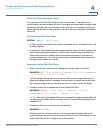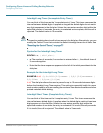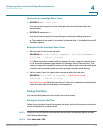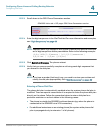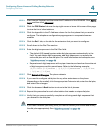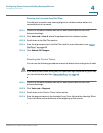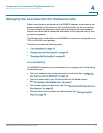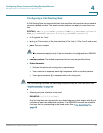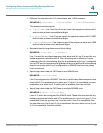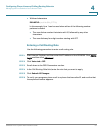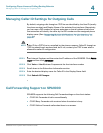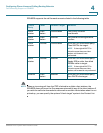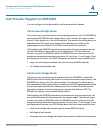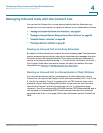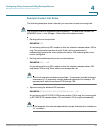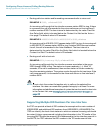
Configuring Phone Lines and Calling Routing Behavior
Managing the Line Selection for Outbound Calls
SPA9000 Voice System Administration Guide 80
4
• Different line interfaces for U.S., international, and 1-800 numbers
EXAMPLE: (<:L1,2>9xx. | <:L3>011852xx. | <:L4>1800xxxxxxx)
This example has three parts:
• <:L1,2>9xx. Line 1 and Line 2 can be used if the sequence starts with 9
and includes at least two additional digits.
• <:L3>011852xx. Line 3 can be used if the sequence starts with 011852
and includes at least two additional digits.
• <:L4>1800xxxxxxx. Line 4 can be used if the sequence starts with 1800
and includes at least seven additional digits.
• Separate lines for long distance and local calling
EXAMPLE: (<:L1>9xx. | <:L2>8xx.)
Line 1 is used for any dialed sequence that starts with 9. Line 2 is used for any
dialed sequence that starts with 8. This call routing rule is effective if users
understand that 9 is the steering digit for long distance (with Line 1 configured
for the ITSP and its inexpensive long distance service) and that 8 is the steering
digit for local calls (with Line 2 configured for a SPA400 that has local phone
lines connected).
• Specifying a hunt order for FXO lines on one SPA400 unit
EXAMPLE: (<:L2{1,2}>8xx)
Line 2 is configured for a SPA400. This line is used for any dialed sequence that
starts with 8. The preference is to seize port 1. If port 1 is unavailable, the next
preference is to seize line 2. If neither port is available, then the call fails.
• Specifying a hunt order for FXO lines on multiple SPA400 units
EXAMPLE: (<:L4{1},3,2{2,4}>9xx)
Lines 2, 3, and 4 are configured for SPA400 units. These lines are used for any
dialed sequence that starts with 9. The preference is to use Line 4, port 1. If it is
unavailable, then any port on Line 3 can be used. If Line 3 is unavailable, then
the next choice is Line 2, port 2. If it is unavailable, the next choice is Line 2, port
4. If it is unavailable, then the call fails.



